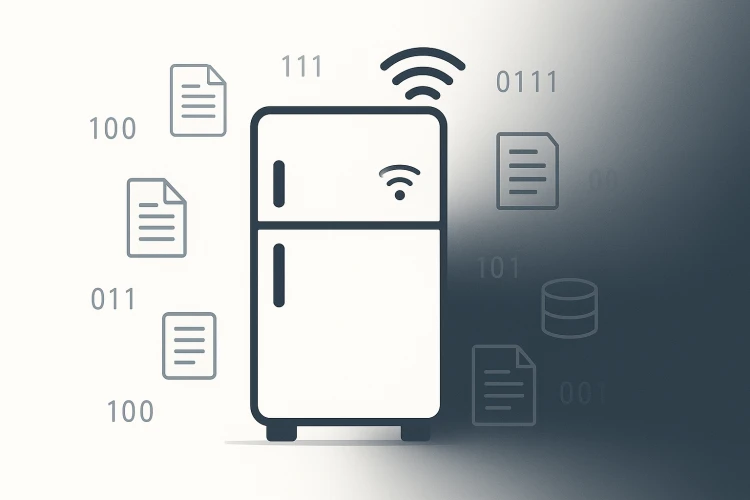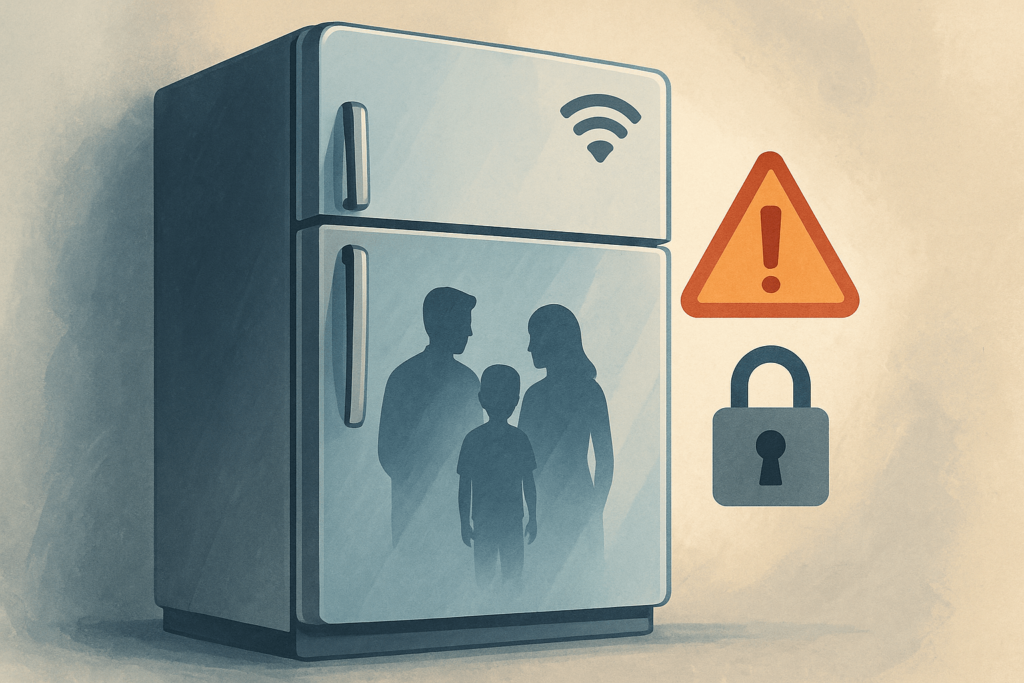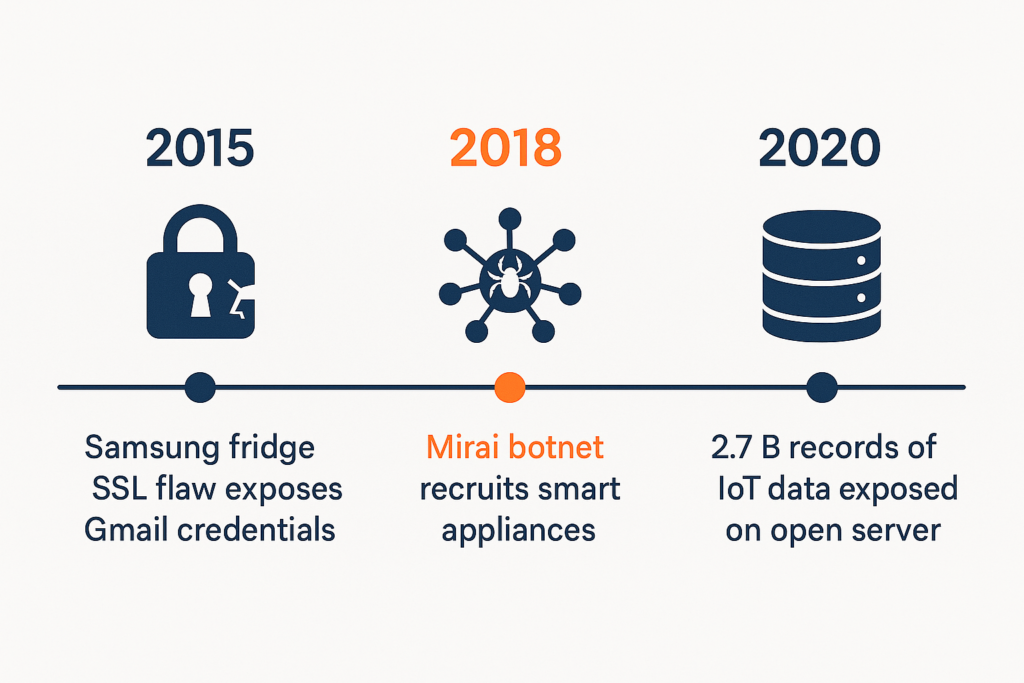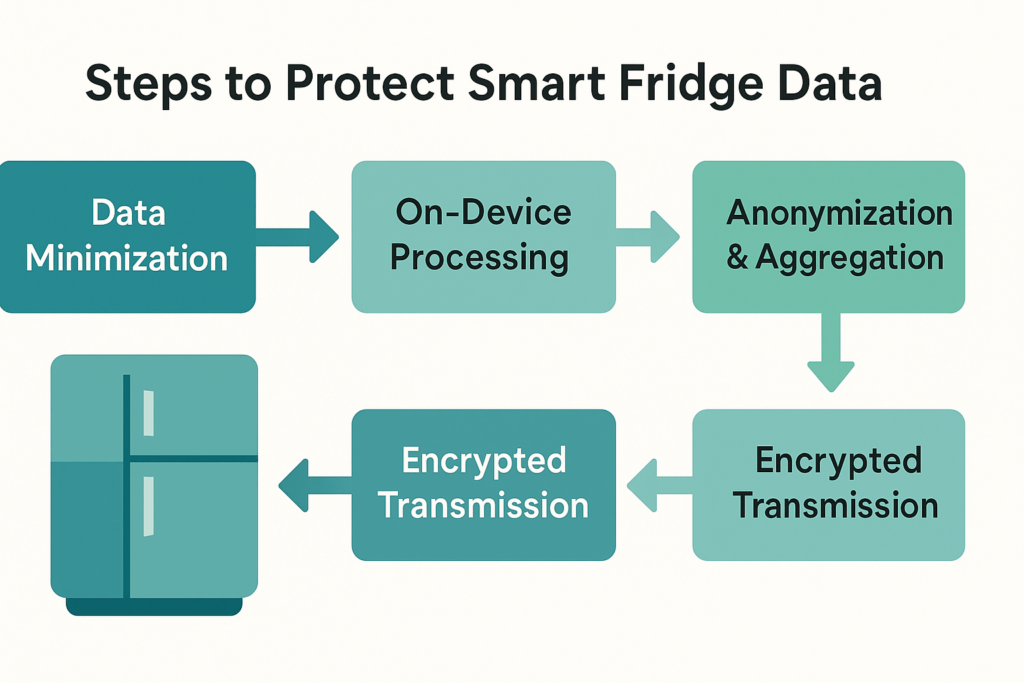Dark Data in IoT: What Your Smart Fridge Is Secretly Collecting
The Internet of Things (IoT) revolution means even everyday appliances—from fridges to ovens—are now constantly online and collecting data. But here’s the kicker: most of this data never sees the light of day. (Kind of like that mystery Tupperware in the back of your fridge.) Much like “dark matter” in space, dark data refers to […]

The Internet of Things (IoT) revolution means even everyday appliances—from fridges to ovens—are now constantly online and collecting data. But here’s the kicker: most of this data never sees the light of day. (Kind of like that mystery Tupperware in the back of your fridge.)
Much like “dark matter” in space, dark data refers to information collected by devices that goes unused and unseen by consumers. In fact, industry analysts warn that “dark data,” or unexamined data, makes up roughly 80% of all digital informationsealevel.com . The IoT boom has only added fuel to this fire: a McKinsey study found that typically less than 1% of IoT data gets analyzedmckinsey.com . Translation: your smart fridge might be gossiping about your midnight snack habits way more than anyone actually listens.
Fun fact: Global connected IoT devices are projected to rise from about 18.8 billion in 2024 to over 40 billion by 2030iot-analytics.com . That’s a lot of chatty appliances.

Demand for connected devices is exploding faster than popcorn in a smart microwave. In 2023 there were an estimated 16.6 billion active IoT devices worldwide, heading toward 40 billion by 2030iot-analytics.com . Every new gadget—from smart thermostats to voice assistants—generates streams of information. By 2025 the global datasphere will swell to 163 zettabytes (ZB), up from 16.1 ZB in 2016seagate.com . About half of that (roughly 79.4 ZB) will come from IoT devices aloneblogs.idc.com . Yet despite this deluge, most data remains “dark”—like today’s oil rigs that analyze just ~1% of their sensor datamckinsey.com .
Chart note: The global datasphere surges from ~16 ZB in 2016 to ~163 ZB by 2025seagate.com , with IoT devices accounting for about 79.4 ZBblogs.idc.com .
Here’s where it gets personal: Your smart fridge might be quietly capturing far more information than it uses. Consumer testing shows that even using a smart appliance once daily can generate 3.4–19 MB per week of datacepro.com . That’s the equivalent of tens of thousands of text messages monthly—just from your refrigeratorcepro.com . (Who knew your fridge had so much to say?)
Bottom line: Smart appliances churn out logs and sensor readings (power usage, door openings, even voice commands) that most users never see. By definition, much becomes “dark”—stored in corporate clouds or device caches, waiting for someone to care. It’s like digital hoarding, but with way better compression algorithms.
What Is “Dark Data” in IoT?
“Dark data” isn’t evil data – it’s simply data that exists but isn’t put to use (kind of like that junk drawer in your kitchen). Gartner famously estimates that 80% of all business data is dark, lurking unseen in archives and logssealevel.com . In smart homes, this could be anything from raw sensor readings to that awkward moment when your voice-activated oven logs your off-key shower singing (because the wake-word detector misfired).
Often dark data is just the byproduct of normal device functions – like how your freezer logs temperatures to ensure your ice cream stays perfectly scoopable, but nobody ever looks at that data unless something goes horribly wrong. One security group notes that “we do not know the full range of data that connected devices generate…what is collected by servers and what persists on the device itself”privacyinternational.org . Even the companies making these gadgets sometimes seem as surprised as we are about what gets recorded.
Dark data can also hide in hidden device caches – like how Amazon Echo speakers keep small audio caches locally (constantly overwritten, like a paranoid secret agent’s burner phone)privacyinternational.org . The real kicker? We often have no clue what permanent digital footprints our smart devices are leaving in the cloud. Who knew your fridge could be such a gossip?
Privacy Risks: What Your Fridge Might Be Leaking

All this unseen data creates serious privacy risks (and not just because your fridge might judge your midnight snack habits). The most obvious danger? Unintentional data collection. Smart devices often gather way more personal context than users realize. Picture this: your fridge’s voice assistant might be passively logging every kitchen conversation—especially those awkward moments when it mishears “add milk” as “call mom.”
Third-party sharing is another headache. Researchers found that every major smart appliance brand tested was shipping detailed user data back to headquarterscepro.com . We’re talking 3.4–19 MB of your life’s minutiae transmitted weekly—because apparently manufacturers really need to know how often you raid the leftovers at 2 AM. Worse yet, this data often includes zip codes, birthdates, and even GPS coordinates (your fridge is basically a snitch with a freezer compartment).
Beyond oversharing, IoT devices can be security trainwrecks. Remember when hackers used a Samsung smart fridge to steal Gmail credentials?securityaffairs.com Turns out your appliance can become the weakest link in your digital life (who knew the salad drawer came with such risks?).
The stats get scarier: 98% of IoT device traffic travels unencrypteddigi.com , meaning your smart toaster’s communications are about as private as a subway announcement. And with IoT cyberattacks surging 400% in a yeardigi.com , your coffee maker might soon be mining Bitcoin for Russian hackers.
The bottom line? Our homes are filling with devices that collect shockingly intimate data, transmit it with all the security of a postcard, and occasionally get hijacked to attack other systemslatimes.com . Maybe it’s time to ask if we really need internet-connected egg trays—or just better privacy laws.
Real-World Breaches and Data Leaks

These risks aren’t just theoretical—they’ve played out in some seriously bizarre ways. Back in 2013–2014, the infamous “ThingBot” (or Mirai botnet, if you’re feeling fancy) turned hundreds of thousands of smart devices—yes, including refrigerators—into unwitting cybercriminals. (Who knew your fridge had a side hustle sending spam emails?) latimes.com This wasn’t just a quirky tech story—it proved that even your appliances could become foot soldiers in large-scale cyberattacks.
Fast forward to more recent times, and things haven’t improved much. A security researcher stumbled upon a jaw-dropping 2.7 billion record breach involving IoT devices from Mars Hydro and LG-LED (yes, the plant-lighting folks). asimily.com We’re talking 1.17 terabytes of exposed data—Wi-Fi passwords, network names, device IDs, you name it. The kicker? This wasn’t even a sophisticated hack—just someone forgetting to lock the digital front door. Oops.
Smart appliances have their own special brand of privacy nightmares. Consumer Reports found that nearly all tested devices were constantly “phoning home” with your data (because apparently your fridge needs to gossip about your eating habits). cepro.com European consumer groups have hilariously (and accurately) accused these gadgets of letting companies “peer into our pantries.” thecounter.org The takeaway? Whether it’s hackers breaking in or manufacturers quietly collecting data, IoT devices have proven they can’t be trusted to mind their own business.
Shining a Light: Reducing Dark Data and Protecting Privacy

Given these risks, how can we minimize dark data and keep private information safe? (Spoiler: it’s not by putting your smart fridge in a Faraday cage.) The key is privacy by design: limit data collection from the outset and sanitize what must be collected. Here’s the technical playbook:
- Data Minimization: Only collect what’s strictly needed. Like that fridge – does it really need to know your age and exact coordinates to tell you you’re out of milk? Privacy regulations (looking at you, GDPR) demand organizations only process personal data for specific purposes trustarc.com . Developers can make sensitive details optional or remove them entirely if unused. (Pro tip: if a field isn’t essential, ditch it.)
- Edge Processing: Do the heavy lifting on the device itself. Your smart fridge can analyze its own sensor data to say “milk low” instead of streaming live footage of your questionable leftovers to the cloud. Techniques like Federated Learning train on local data and only share model updates. Keep it local, keep it safe.
- Anonymization & Aggregation: When data must travel, strip personal identifiers. Hash it, tokenize it, get creative! Instead of your exact GPS coordinates, send neighborhood-level data. Researchers are exploring differential privacy for IoT – masking individual patterns in crowd data link.springer.com . Even simple steps like anonymizing timestamps help.
- Secure Transmission and Storage: Encrypt everything. The shocking truth? 98% of IoT traffic is unencrypted digi.com . Use TLS/SSL like your smartphone does (looking at you, Samsung fridge that got hacked) securityaffairs.com . Server data should be encrypted too – because breaches happen.
- Limited Retention and Automatic Deletion: Don’t hoard data. Voice assistants like Google Home keep only seconds of audio if no wake word is detected privacyinternational.org . Appliances should overwrite logs daily. With U.S. privacy laws tightening, companies must justify retention periods. (Translation: ask how long your data sticks around.)
- Regular Updates and Patch Management: Not strictly data sanitization, but critical. Unpatched flaws cause leaks – in fact, 60% of IoT security breaches stem from outdated firmware jumpcloud.com . Choose brands committed to long-term support (most won’t even specify an update period) innovation.consumerreports.org .
- User Control: Give people visibility and control. Clear privacy settings, data deletion options, and simple consent flows matter. Some platforms now show what’s being shared (check your network traffic!). When buying smart devices, read privacy policies – though stats show only 14% do businesswire.com . Disable unnecessary features like voice recording.
In the U.S., change is brewing. The FTC has called out smart products’ lack of transparency on updates and retention ftc.gov . California’s CCPA gives consumers rights to know and delete data. Combined with technical safeguards, these efforts aim to shrink IoT’s dark data shadow. (Because nobody wants their fridge testifying against them.)
In summary, smart fridges and their high-tech cousins are basically data vacuum cleaners—sucking up way more info than we realize (seriously, your fridge knows when you sneak that midnight snack). Most of this data lurks in the shadows, unseen by users and potentially vulnerable. But here’s the good news: by shining a light on these hidden data flows and pushing for better privacy protections (encryption, anyone?), we can keep our kitchen secrets… well, secret.
Key Takeaways:
- IoT devices are data factories. We’re talking tens of billions of connected gadgets (yes, your toaster counts) that’ll generate nearly 80 zettabytes of data by 2025—that’s enough to make your head spin. And get this: most of this data just sits there collecting digital dust.
- Dark data poses privacy risks. Hidden logs, sneaky recordings, and usage stats in smart appliances can reveal way too much about your habits (like how often you really eat ice cream). Studies show most of this data gets shipped off to manufacturers—sometimes without clear consent. Not cool.
- Security flaws magnify the danger. Vulnerabilities in IoT gadgets have been exploited for everything from stealing passwords to building botnets (yes, your fridge could join a hacker army). The scariest part? About 98% of IoT traffic goes completely unencrypted—basically sending your data out in the digital equivalent of a glass box.
- Protect your data. Fight back by limiting what your devices can collect (turn off unnecessary sensors), keeping firmware updated, and choosing brands with solid privacy practices. Bonus points for advocating “privacy by design” and keeping data processing local when possible.
By staying informed and proactive (and maybe being a little paranoid), we can enjoy smart appliances without turning our personal lives into an open book for data collectors. After all, some things—like how much cheese you really eat—should stay between you and your fridge.
